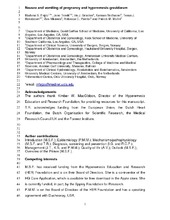Nausea and vomiting of pregnancy and hyperemesis gravidarum
Fejzo, Marlena Schoenberg; Trovik, Jone; Grooten, Iris J.; Sridharan, Kannan; Roseboom, Tessa J.; Vikanes, Åse Vigdis; Painter, Rebecca C.; Mullin, Patrick M.
Peer reviewed, Journal article
Accepted version
Permanent lenke
https://hdl.handle.net/1956/22335Utgivelsesdato
2019Metadata
Vis full innførselSamlinger
Originalversjon
https://doi.org/10.1038/s41572-019-0110-3Sammendrag
Nausea and vomiting of pregnancy (NVP) is a common condition that affects as many as 70% of pregnant women. Although no consensus definition is available for hyperemesis gravidarum (HG), it is typically viewed as the severe form of NVP and has been reported to occur in 0.3–10.8% of pregnant women. HG can be associated with poor maternal, fetal and child outcomes. The majority of women with NVP can be managed with dietary and lifestyle changes, but more than one-third of patients experience clinically relevant symptoms that may require fluid and vitamin supplementation and/or antiemetic therapy such as, for example, combined doxylamine/pyridoxine, which is not teratogenic and may be effective in treating NVP. Ondansetron is commonly used to treat HG, but studies are urgently needed to determine whether it is safer and more effective than using first-line antiemetics. Thiamine (vitamin B1) should be introduced following protocols to prevent refeeding syndrome and Wernicke encephalopathy. Recent advances in the genetic study of NVP and HG suggest a placental component to the aetiology by implicating common variants in genes encoding placental proteins (namely GDF15 and IGFBP7) and hormone receptors (namely GFRAL and PGR). New studies on aetiology, diagnosis, management and treatment are under way. In the next decade, progress in these areas may improve maternal quality of life and limit the adverse outcomes associated with HG.
